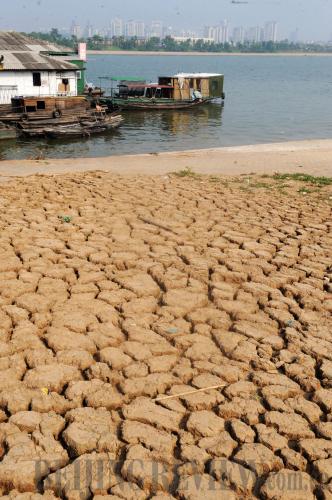|
 |
|
SEVERE DROUGHT: Much of the riverbed of the Xiangjiang River in Hunan Province is exposed due to a drop in the water level caused by several rainless months (LONG HONGTAO) |
Local governments at all levels have put irrigation and water conservation tasks at the top of their agenda with the beginning of the Chinese lunar New Year, which fell on February 3 this year.
The focus on irrigation and water conservation is based on strong Central Government policy support for improving water management. On January 29, the State Council and the Central Committee of the Communist Party of China issued an important policy document outlining support for the reform and development of irrigation and water conservation systems. It was the first time since the founding of New China in 1949 the government has taken a comprehensive approach to reforming and developing national irrigation and water conservation projects.
The document emphasized the importance of irrigation and water conservation in China's economic and social development. It said irrigation and water conservation is an indispensable prerequisite for modern agricultural construction, an irreplaceable fundamental pillar of social and economic development, and a guarantee for the improvement of the environment. It has strategic significance and is conducive to improving public welfare. Speeding up the development of irrigation and water conservation will not only stimulate the development of agriculture and rural areas, but will also improve the overall development of society and the economy. Development of irrigation and water conservation projects not only can prevent serious flooding, but also help guarantee water and food supply, and has a close bearing on the country's economic, environmental and national security.
According to the new policy, through five to 10 years of efforts, outdated irrigation and water conservation projects will be totally phased out. To accomplish this goal, the government will increase investment in these fields and encourage a variety of financing methods for such projects. The government expects to increase investment in irrigation and water conservation to 4 trillion yuan ($606.6 billion) by 2020, double the level in 2010.
Why now?
China has attached great significance to water control since ancient times. Well-known irrigation and water conservation projects such as the Dujiangyan Irrigation Project in Sichuan Province, Zhengguoqu Irrigation Project in Shaanxi Province and Lingqu Canal in Guangxi Zhuang Autonomous Region were all built more than 2,000 years ago. Since the founding of New China, the country has built and reinforced a huge number of irrigation and conservation projects, including more than 100,000 reservoirs and 220,000 km of dikes. In addition, it has increased the acreage of irrigated farmland to 55,000 hectares and raised its installed hydropower capacity to more than 150 million kw.
These projects have played a major role in preventing floods, securing urban and rural water supplies, maintaining water and soil, generating hydropower and improving the biological environment.
| 